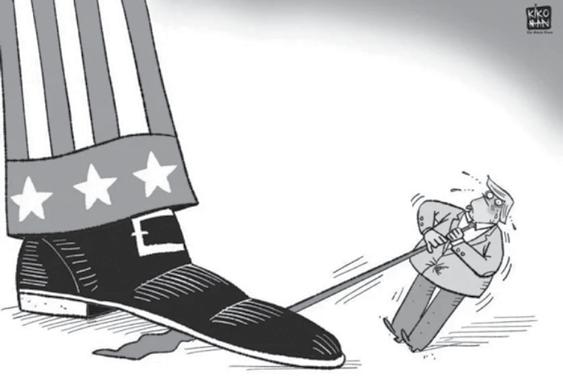
3 minute read
EDCA expansion and Philippine security interests
access to Philippine territories to respond to any military contingencies in key flashpoint of conflicts in Asia: the Taiwan Strait, Korean Peninsula and the South China Sea.
When the Philippines and the United States signed EDCA in 2014, the two countries agreed to train together in order to strengthen their interoperability in responding to natural disasters, humanitarian situations, terrorist threats and maritime security challenges.
Advertisement
With EDCA, the Philippine government allowed the construction of five American military facilities in Fort Magsaysay in Nueva Ecija, Basa Air Base in Pampanga, Antonio Bautista Air Base in Palawan, Mactan-Benito Abuen Air Base in Cebu and Lumbia Air Base in Cagayan de Oro.
Since then, Filipino and American armed forces have been holding joint and combined military exercises in the area of humanitarian assistance and disaster response (HADR), search and rescue operations, counterterrorism cooperation and maritime domain awareness.
What is being downplayed by Filipino and American authorities about EDCA is its strategic intention to counter China’s growing international influence, particularly in the South China Sea where most parts of the West Philippine Sea are located.
In the joint press briefing with Secretary Galvez on Feb. 2, 2023, U.S. Secretary of Defense Lloyd J. Austin III admitted that EDCA is “part of our efforts to modernize our alliance, and these efforts are especially important as the People’s Republic of China continues to advance its illegitimate claims in the West Philippine Sea.”
Thus, EDCA’s larger goal is to support American efforts to get strategic advantage over China amidst their worsening major power rivalry.
In fact, Pentagon leaders just requested last week the U.S. Congress to approve the $842-billion budget for the Department of Defense (DOD) in order to modernize the U.S. military as it prepares for a possible confrontation with China.
General Mark Milley, Chairman of the Joint Chiefs of Staff, stressed during the most recent budget hearing that
China’s current actions “are moving it down the path toward confrontation and potential conflict with its neighbors and possibly the United States.” He added that preparing for war “is extraordinarily expensive, but it’s not as expensive as fighting a war. And this budget prevents war and prepares us to fight it if necessary.”
Apparently, EDCA expansion is part of U.S. access arrangements in Asia to decisively implement American military deterrence strategy and defense preparation plan against China. As such, EDCA expansion largely serves American military interests to counter China rather than caters to Philippine national interests to harmoniously live at peace with China.
Hence, EDCA expansion can inevitably harm Filipino security interests as China can hit the Philippines in armed conflict situations with the U.S. because of American military facilities in Philippine territories. The Chinese embassy in Manila already warned that EDCA expansion can “seriously harm Philippine national interests and endanger regional peace and stability.”
The Chinese embassy further explained, “Whereas the U.S. claims that such cooperation is intended to help the disaster relief efforts of the Philippines and some Americans even tout the EDCA sites as driver of local economy, it is plain and simple that those moves are part of the U.S. efforts to encircle and contain China through its military alliance with this country.”
Filipino and American security officials exclaim that EDCA aims to strengthen Philippine-American military alliance and to reaffirm the commitment of the U.S. to defend the Philippines against external attacks.
EDCA, however, can only deepen Philippine reliance on the U.S. for its defense. Instead of relying heavily on the U.S. for its national defense, the Philippines needs to pursue self-reliance to defend itself.
Senator Imee Marcos, chair of the Senate committee on foreign relations, hits the nail on the head when she calls for the revival of the Self Reliance Defense Program (SRDP) initiated in 1974 by then president Ferdinand E. Marcos. She urges the Armed Forces of the Philippines
(AFP) to resuscitate the SRDP in order to “scale down our dependence on foreign goodwill in the sticky web of geopolitics.”
Senator Marcos also challenges the EDCA expansion when she underscores that EDCA “is addressing the escalation of tensions in the Taiwan strait, not the Philippine interests in the West Philippine Sea.”
Local Filipino residents have also voiced their apprehensions against EDCA expansion. Governor Manuel Mamba of Cagayan province already conveyed worries of his constituents that EDCA could turn his province “into a key target of the Chinese military if a conflict involving the U.S. military breaks out over Taiwan.”
Though Governor Mamba showed his respect to President Marcos Jr.’s approval on EDCA expansion, he said, “It is the President’s call, not mine,” highlighting that “I maintain my stand against any foreign forces stationed in my province. Still, I am against EDCA sites in my province.” Governor Mamba also raised the lack of local consultations u PAGE 7





